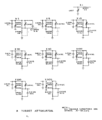Z: Difference between revisions
No edit summary |
David Wise (talk | contribs) m (correct discontinuation year based on 1968-69 catalogs) |
||
| Line 5: | Line 5: | ||
caption=Type Z front view| | caption=Type Z front view| | ||
introduced=1960 | | introduced=1960 | | ||
discontinued= | discontinued=1969 | | ||
series=[[500-series scopes]]| | series=[[500-series scopes]]| | ||
manuals= | manuals= | ||
Revision as of 11:14, 2 August 2017
Template:Plugin Sidebar 2 The Tektronix Type Z is a comparator plug-in for 500-series scopes. Its two main subsystems are a differential amplifier and a precision variable DC voltage source, which can be used as one of the amplifier inputs. This allows DC-coupled measurements of small signals with large DC offsets. Its maximum sensitivity is 50 mV/div, and it achieves 40,000 to 1 common-mode rejection at DC and low frequencies. Its risetime as a general-purpose amplifier is 27 ns (13 MHz bandwidth), but it can track a common-mode risetime of 7 ns.
The Type Z has two inputs, A and B, plus a precision comparison voltage, VC, that is adjustable from 0 to +/-1 V, 10 V, or 100 V via a ten-turn pot. It's possible to view VA, -VB, VA-VB, VA-VC, or VC-VB.
Unlike later comparators, it has a separate step attenuator for each input, permitting the user to view the difference between signals of widely differing amplitudes. It is also the only comparator that can handle +/- 100 V common mode at full sensitivity. The Type Z uses two turret attenuators.
With a pair of "Disconnect Signal" buttons, the Type Z was the first of the movement toward a "GND" position on the input switches.
The Type Z was introduced in 1960 and uses both tubes and transistors, capitalizing on the strengths of each. It was dropped after 1968.
The Type P6023 probe, introduced in 1962 with R and C compensation, was specifically designed for the Type Z but also marketed for the Type G.
Specifications
please add
Links
Pictures
-
Front View
-
Left Side
-
Schematic
-
Attenuators
-
-
-
-
-
-
-










